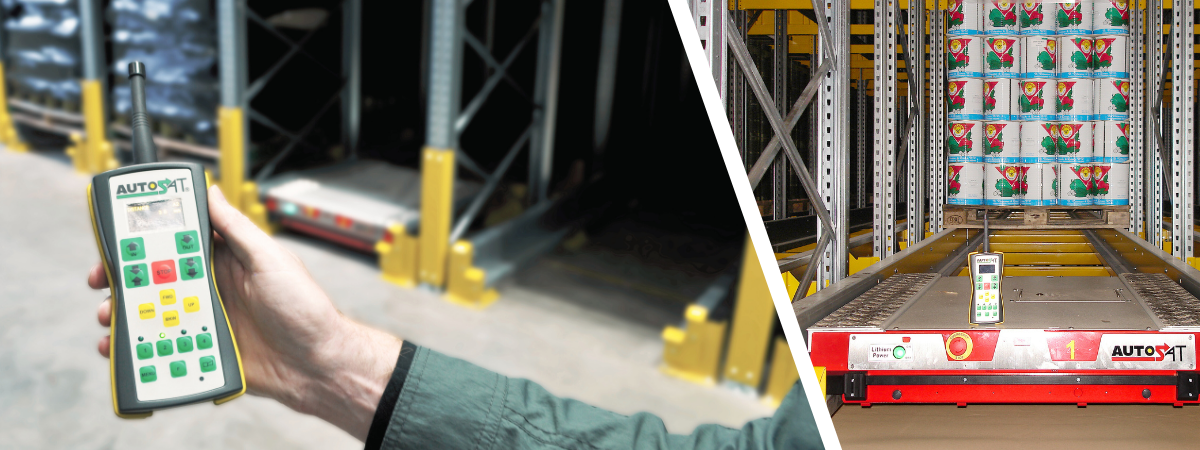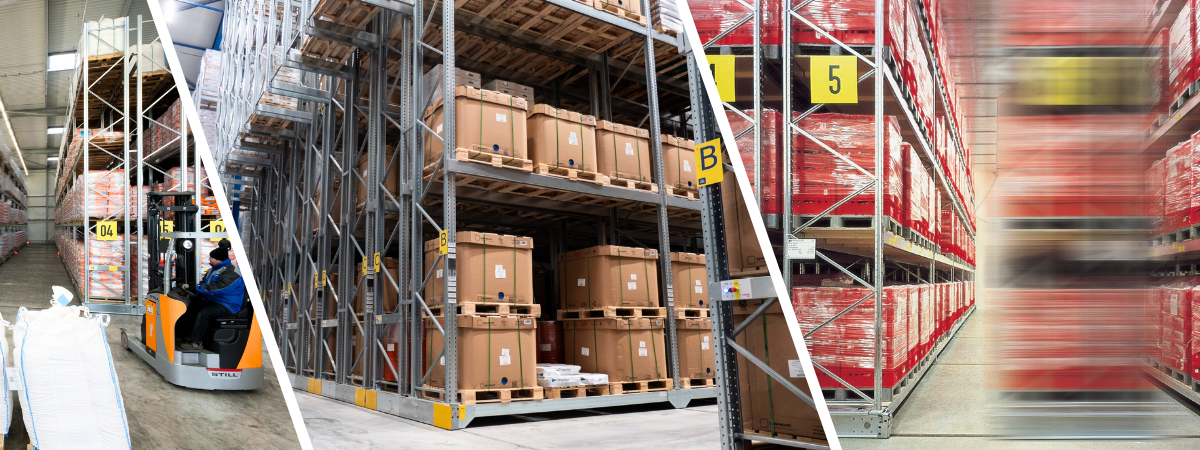Maximising pallet storage capacity is a crucial challenge for many warehouses. The dilemma? More compact storage always means sacrificing traffic space and flexibility. When floor space is limited and stock keeps growing, choosing between a pallet shuttle system and mobile pallet racking becomes critical. Both can double your storage density, but they work in fundamentally different ways.
The choice depends on factors such as product type, turnover rate, available space and safety requirements. In this blog, we discuss the advantages and disadvantages of both options so that you can determine which solution is better suited to your application.
Pallet shuttle systems
A pallet shuttle system is a dynamic or semi-automated storage system that uses self-propelled, battery-powered "shuttles". These shuttles run on rails through compact pallet racks to retrieve and deliver pallets.

Advantages
High storage density: A typical drive-in rack might go 6-8 pallets deep. Shuttle systems routinely handle 20-40 pallet positions per channel, dramatically increasing density while maintaining safe access. This allows you to maximise the use of available space by storing pallets deep in racks without multiple aisles.
Efficiency/speed: Automates the storage and retrieval process. A shuttle works one-on-one with a forklift driver without them having to wait for each other. For example, if two forklifts are operational at the shuttle racks, it makes sense to use two shuttles as well. This shortens lead times and increases productivity.
Flexibility in stock management: Ideal for First In, First Out (FIFO) operations, where you work from one side of the racking. The system also supports Last In, First Out (LIFO) if needed, in which case work is carried out on both sides of the racking (one input side and one output side). The choice depends on the needs of the warehouse and the available space.
Improved safety: Unlike drive-in racking, for example, much less forklift traffic is required, as it is no longer necessary to drive into the racking. This significantly reduces the risk of accidents or damage. It also increases the speed in your warehouse.
Disadvantages
Higher initial investment: The purchase and installation of the racks are roughly the same as for drive-in racks. The cost of the shuttle(s) must also be added to this.
Maintenance: Annual servicing is essential to maintain performance. While maintenance costs are reasonable, budget for preventive service to minimise downtime. Dexion offers preventive service and maintenance with an expert breakdown service and the availability of a loan shuttle. However, it is always advisable to have at least two shuttles available so that you are never dependent on an unexpected breakdown.
Dependence on technology: Malfunctions can never be 100% prevented. Downtime can cause temporary problems and slow down warehouse operations. To minimise this risk, having backup shuttles and a reliable service agreement is essential.
Small batches: When pallets are placed in and/or removed from the shuttle rack in small numbers, it may be necessary to place the shuttle in a different channel after each operation. This obviously takes extra time and makes this solution less suitable for stocks with a wide variety of products.
Mobile pallet racks (MOVO)
Think of mobile pallet racking as a sliding bookshelf for your warehouse. Racks sit on motorised bases that glide along floor rails. Need access to row 5? The system opens an aisle exactly where you need it. One working aisle replaces six or seven fixed ones - while keeping every pallet directly accessible.

Advantages
Maximum space utilisation: MOVO eliminates the need for fixed aisles between all rows of racks, increasing storage capacity by up to +95%. Conversely, the same stock can be stored in approximately half the space previously required, significantly reducing construction and land costs for the building.
Direct access: The system provides access to all pallets without moving other pallets.
Flexibility and multifunctionality: Suitable for various product types and sizes, including longer or irregularly shaped goods. With mobile pallet racks, beam levels can also be easily adjusted retrospectively. In addition, the bases can also be constructed with cantilever racks for long goods.
Easy installation: Can be installed relatively quickly and adapted to changing needs. Because a new warehouse often anticipates growth and provides extra space compared to the old situation, investing in mobile racks is often unnecessary. Nevertheless, in anticipation of future needs and at relatively low cost, the rails can be installed in the floor during new construction, so that it is easy to switch to mobile racks later on.
Ideal for cold stores and freezer rooms: For cold stores and freezer rooms, MOVO delivers dramatic savings. A 10,000-pallet cold store might cost £2.5 million to build and £500,000 annually to run. With MOVO, you can store the same volume in half the space, cutting construction costs nearly in half while barely increasing operating costs. When storing frozen goods costs £10-15 per pallet location per year, doubling capacity without doubling facility costs makes the ROI calculation straightforward.
Disadvantages
Higher initial investment: The purchase and installation costs of mobile racking are higher than for traditional systems. However, the warehouse can be half the size and therefore much more cost-effective.
Maintenance: The mechanical system requires regular servicing, but the technology is relatively simple and reliable. Most downtime stems from collision damage or blocked sensors—preventable issues with good warehouse practices. Dexion offers a complete service for this.
Floor requirements: In existing floors, the possibility of milling rails is often limited. A renovation rail is available for this purpose. This very slim rail has a very shallow milling depth. If milling the floor is not permitted at all, the rail can be mounted on top of the floor. An extra layer of concrete is then applied to the floor so that the rails are flush with the floor again.
High inbound and outbound: Because a MOVO installation only requires one aisle, it can be challenging when working with multiple forklifts. One solution could be to have one forklift working in the aisles and one forklift in front of it, so that there is always a transfer via P&D (pick & deposit) locations. Many high-throughput operations solve this by installing multiple MOVO blocks, each with dedicated aisles for parallel forklift operations.
Which system fits your operation?
Consider shuttle systems when you have:
- High-volume stock with relatively few SKUs
- Consistent pallet flows in and out
- Need for FIFO or temperature-controlled storage
- Limited labour for forklift operations
Consider mobile racking when you have:
- A diverse product range requires frequent access to all items
- Need for maximum space efficiency with full selectivity
- Cold or freezer storage (where building costs dominate)
- Plans for future flexibility in rack configuration
Making the right choice
The final choice for compact pallet storage depends on a range of factors, including product characteristics and turnover rate, as well as available space and future plans. Both shuttle systems and mobile racking offer clear advantages, but other solutions may be more suitable in certain situations.
A thorough analysis of the logistics processes and the specific requirements of the warehouse is therefore essential in order to make the right choice. Dexion has more than 60 years of experience and is happy to work with you to determine the right warehouse, including layout and systems.